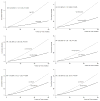Blood biomarkers as predictors of long-term mortality in COPD
- PMID: 29227024
- PMCID: PMC5991987
- DOI: 10.1111/crj.12752
Blood biomarkers as predictors of long-term mortality in COPD
Abstract
Background: Blood biomarkers are easily accessible and might reflect chronic obstructive pulmonary disease (COPD) activity.
Aim: The aim of this study was to determine whether a panel of blood biomarkers [C-reactive protein (CRP), neutrophils, eosinophils, albumin and vitamin D] could predict mortality in COPD.
Methods: We analyzed data from 431 COPD participants to the 2007-2010 National Health and Nutrition Examination Surveys who were followed for a median time of 36 months. COPD was defined as post-bronchodilator forced expiratory volume in 1 second (FEV1) and forced vital capacity ratio <0.70. Weibull survival analysis adjusted for covariates was performed to calculate the risk of mortality associated with the biomarkers, and C-statistics was used to assess their added predictive value.
Results: During follow-up, 38 of the 431 participants died. Participants with high CRP, eosinophil count <2%, hypoalbuminemia and hypovitaminosis D had worse baseline FEV1 and subsequently higher mortality compared to controls. In adjusted analysis, increasing CRP [hazard ratio (HR): 4.45, 95% CI: 1.91-10.37] and neutrophil count (HR: 1.07, 95% CI: 1.03-1.11) as well as decreasing eosinophil count (HR: 7.03, 95% CI: 2.05-24.01) were associated with an increased risk of mortality. The addition of CRP with eosinophil and/or neutrophil count significantly improved a base model for the prediction of mortality which included age, gender, race/ethnicity, body mass index, smoking, poverty income ratio, asthma, diabetes, hypertension and history of stroke or myocardial infarction.
Conclusion: High CRP and neutrophils as well as low eosinophils are predictive of poor COPD prognosis. They also add significant value to prediction models of mortality in COPD.
Keywords: biologic markers; chronic obstructive pulmonary disease; prognosis.
© 2017 John Wiley & Sons Ltd.
Conflict of interest statement
Figures



Similar articles
-
Inflammatory biomarkers and exacerbations in chronic obstructive pulmonary disease.JAMA. 2013 Jun 12;309(22):2353-61. doi: 10.1001/jama.2013.5732. JAMA. 2013. PMID: 23757083
-
Prevalence and features of asthma-COPD overlap in the United States 2007-2012.Clin Respir J. 2018 Aug;12(8):2369-2377. doi: 10.1111/crj.12917. Clin Respir J. 2018. PMID: 29873189 Free PMC article.
-
Can we predict the prognosis of COPD with a routine blood test?Int J Chron Obstruct Pulmon Dis. 2017 Feb 13;12:615-625. doi: 10.2147/COPD.S124041. eCollection 2017. Int J Chron Obstruct Pulmon Dis. 2017. PMID: 28243079 Free PMC article.
-
Defining the role of neutrophil-to-lymphocyte ratio in COPD: a systematic literature review.Int J Chron Obstruct Pulmon Dis. 2018 Nov 5;13:3651-3662. doi: 10.2147/COPD.S178068. eCollection 2018. Int J Chron Obstruct Pulmon Dis. 2018. PMID: 30464448 Free PMC article.
-
Eosinophilia and clinical outcome of chronic obstructive pulmonary disease: a meta-analysis.Sci Rep. 2017 Oct 18;7(1):13451. doi: 10.1038/s41598-017-13745-x. Sci Rep. 2017. PMID: 29044160 Free PMC article.
Cited by
-
The clinical usefulness of neutrophil percentage/albumin ratio in predicting the one-month mortality in chronic obstructive pulmonary disease patients hospitalized with community-acquired pneumonia.BMC Pulm Med. 2025 Jun 9;25(1):288. doi: 10.1186/s12890-025-03757-z. BMC Pulm Med. 2025. PMID: 40490700 Free PMC article.
-
Elevated blood eosinophils in acute COPD exacerbations: better short- and long-term prognosis.Eur Clin Respir J. 2020 Apr 30;7(1):1757274. doi: 10.1080/20018525.2020.1757274. eCollection 2020. Eur Clin Respir J. 2020. PMID: 32489532 Free PMC article.
-
Role of inflammatory cells in airway remodeling in COPD.Int J Chron Obstruct Pulmon Dis. 2018 Oct 12;13:3341-3348. doi: 10.2147/COPD.S176122. eCollection 2018. Int J Chron Obstruct Pulmon Dis. 2018. PMID: 30349237 Free PMC article. Review.
-
Prognostic Usefulness of Basic Analytical Data in Chronic Obstructive Pulmonary Disease Exacerbation.Open Respir Arch. 2023 Sep 20;5(4):100271. doi: 10.1016/j.opresp.2023.100271. eCollection 2023 Oct-Dec. Open Respir Arch. 2023. PMID: 37818452 Free PMC article.
-
Relationship between human serum albumin and in-hospital mortality in critical care patients with chronic obstructive pulmonary disease.Front Med (Lausanne). 2023 Apr 27;10:1109910. doi: 10.3389/fmed.2023.1109910. eCollection 2023. Front Med (Lausanne). 2023. PMID: 37181348 Free PMC article.
References
-
- Heron M. Deaths: leading causes for 2010. Natl Vital Stat Rep. 2013;62(6):1–96. - PubMed
-
- Diaz-Guzman E, Mannino DM. Epidemiology and prevalence of chronic obstructive pulmonary disease. Clin Chest Med. 2014;35(1):7–16. - PubMed
-
- Sciurba FC. Physiologic similarities and differences between COPD and asthma. Chest. 2004;126(2_suppl_1):117S–24S. - PubMed
-
- Barnes PJ. Mechanisms in COPD: differences from asthma. Chest. 2000;117(2_suppl):10S–4S. - PubMed
Publication types
MeSH terms
Substances
Grants and funding
LinkOut - more resources
Full Text Sources
Other Literature Sources
Medical
Research Materials
Miscellaneous

